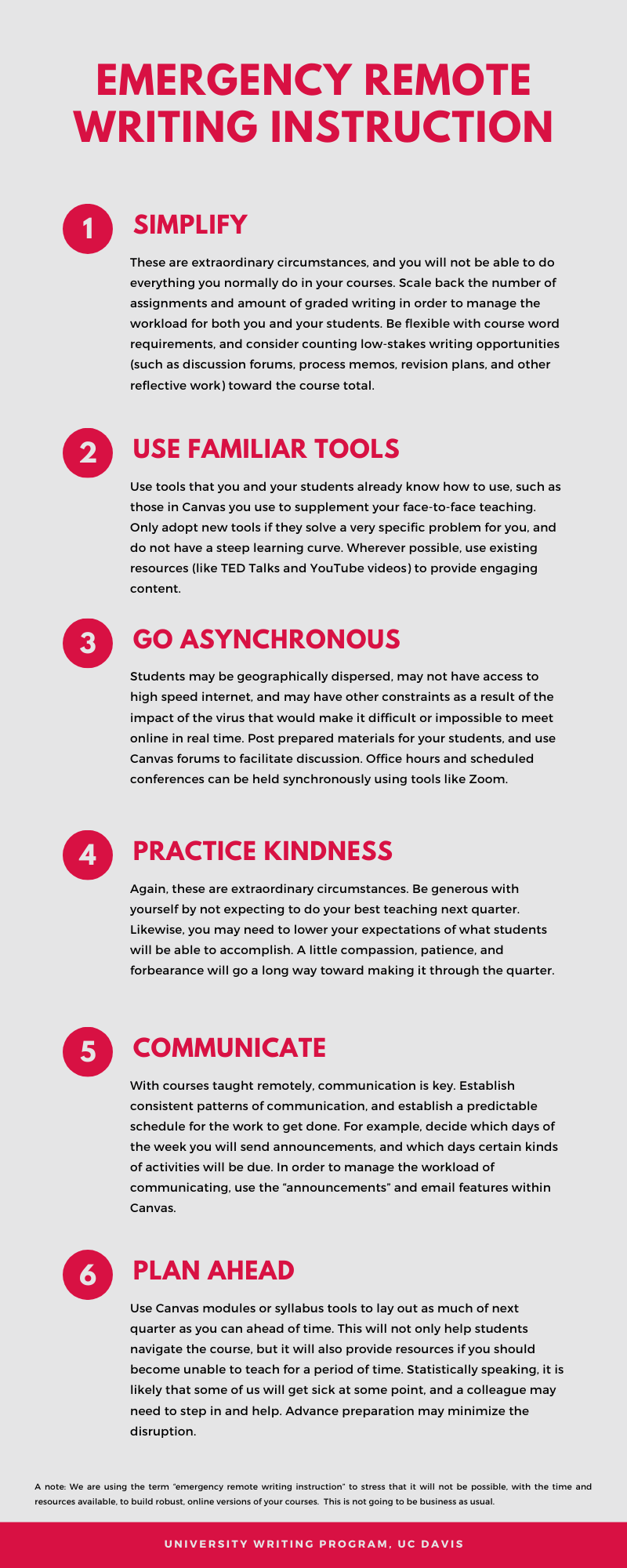 The UWP leadership has developed the following guidelines as instructors prepare to teach remotely in response to the COVID-19 pandemic. We are calling this “emergency remote writing instruction” (as opposed to “online writing instruction”) to stress the fact that it will not be possible, with the time and resources available, to build robust, online versions of your courses. Instead, think in terms of using available means to deliver courses remotely. This is not going to be business as usual.
The UWP leadership has developed the following guidelines as instructors prepare to teach remotely in response to the COVID-19 pandemic. We are calling this “emergency remote writing instruction” (as opposed to “online writing instruction”) to stress the fact that it will not be possible, with the time and resources available, to build robust, online versions of your courses. Instead, think in terms of using available means to deliver courses remotely. This is not going to be business as usual.
With that said, here are the guidelines:
Simplify
These are extraordinary circumstances, and you will not be able to do everything you normally do in your courses. Scale back the number of assignments and amount of graded writing in order to manage the workload for both you and your students. Be flexible with course word requirements, and consider counting low-stakes writing opportunities (such as discussion forums, process memos, revision plans, and other reflective work) toward the course total.
Use Familiar Tools
Use tools that you and your students already know how to use, such as those in Canvas you use to supplement your face-to-face teaching. Only adopt new tools if they solve a very specific problem for you, and do not have a steep learning curve. Wherever possible, use existing resources (like TED Talks and YouTube videos) to provide engaging content.
Go Asynchronous
Students may be geographically dispersed, may not have access to high speed internet, and may have other constraints as a result of the impact of the virus that would make it difficult or impossible to meet online in real time. Post prepared materials for your students, and use Canvas forums to facilitate discussion. Office hours and scheduled conferences can be held synchronously using tools like Zoom.
Practice Kindness—to Yourself and Others
Again, these are extraordinary circumstances. Be generous with yourself by not expecting to do your best teaching next quarter. Likewise, you may need to lower your expectations of what students will be able to accomplish. A little compassion, patience, and forbearance will go a long way toward making it through the quarter.
Communicate
With courses taught remotely, communication is key. Create consistent patterns of communication, and establish a predictable schedule for the work to get done. For example, decide which days of the week you will send announcements, and which days certain kinds of activities will be due. In order to manage the workload of communicating, use the “announcements” and email features within Canvas.
Plan Ahead
Use Canvas modules or syllabus tools to lay out as much of next quarter as you can ahead of time. This will not only help students navigate the course, but it will also provide resources if you should become unable to teach for a period of time. Statistically speaking, it is likely that some of us will get sick at some point, and a colleague may need to step in and help. Advance preparation may minimize the disruption.
Ask for Help
You are not expected to do this alone. For help designing your Canvas site and using tools for instruction and communication, get in touch with Kory Lawson Ching <kching@ucdavis.edu> or Theresa N Walsh <tnwalsh@ucdavis.edu>, your ADs of online writing instruction. For help with scaling back your courses and other curricular matters, contact the coordinators for those specific courses (listed below). For general UWP policy questions, contact UWP Director Dana Ferris <drferris@ucdavis.edu>.
- UWP 1: Daniel L Melzer <dlmelzer@ucdavis.edu>, Andrea M Ross <amross@ucdavis.edu>
- ELW: Trish Serviss <pcserviss@ucdavis.edu>, Beth E Pearsall <nepearsall@ucdavis.edu>
- EMS: Kelly A Crosby <kacrosby@ucdavis.edu>, Erika I-Tremblay <eitremblay@ucdavis.edu>
- 101: Amy M. Clarke <amclarke@ucdavis.edu>
- 102: Jillian Azevedo <jazevedo@ucdavis.edu>
- 104: Rebekka Andersen <randersen@ucdavis.edu>
